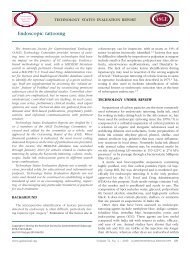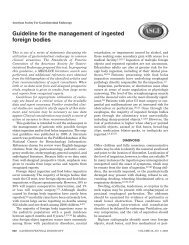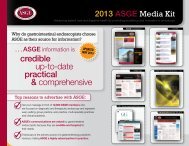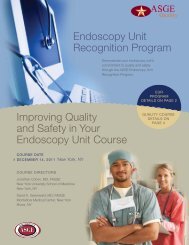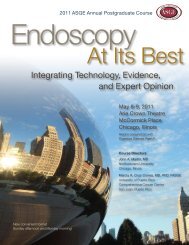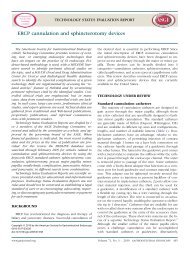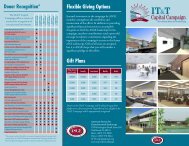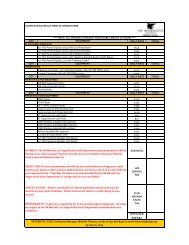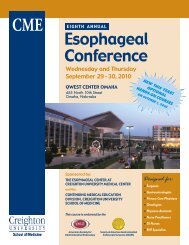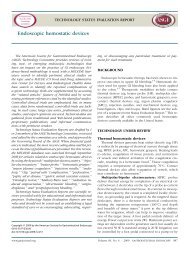Endoscopic banding devices - American Society for Gastrointestinal ...
Endoscopic banding devices - American Society for Gastrointestinal ...
Endoscopic banding devices - American Society for Gastrointestinal ...
Create successful ePaper yourself
Turn your PDF publications into a flip-book with our unique Google optimized e-Paper software.
TECHNOLOGY STATUS EVALUATION REPORT<strong>Endoscopic</strong> <strong>banding</strong> <strong>devices</strong>The <strong>American</strong> <strong>Society</strong> <strong>for</strong> <strong>Gastrointestinal</strong> Endoscopy(ASGE) Technology Committee provides reviews of existing,new, or emerging endoscopic technologies thathave an impact on the practice of GI endoscopy. Evidence-basedmethodology is used with a MEDLINE literaturesearch to identify pertinent clinical studies on thetopic and a MAUDE (Food and Drug AdministrationCenter <strong>for</strong> Devices and Radiological Health) databasesearch to identify the reported complications of a giventechnology. Both are supplemented by accessing the ‘‘relatedarticles’’ feature of PubMed and by scrutinizingpertinent references cited by the identified studies. Controlledclinical trials are emphasized, but, in manycases, data from randomized controlled trials are lacking.In such cases, large case series, preliminary clinicalstudies, and expert opinions are used. Technical data aregathered from traditional and Web-based publications,proprietary publications, and in<strong>for</strong>mal communicationswith pertinent vendors. Technology Status EvaluationReports are drafted by 1 or 2 members of the ASGETechnology Committee, are reviewed and edited by thecommittee as a whole, and approved by the governingboard of the ASGE. When financial guidance is indicated,the most recent coding data and list prices at the time ofpublication are provided. For this review, the MEDLINEdatabase was searched through June 2007 <strong>for</strong> articles relatedto <strong>banding</strong> <strong>devices</strong> by using the keywords ‘‘<strong>banding</strong>,’’‘‘ligation,’’ and ‘‘band ligation’’ plus ‘‘tumor,’’‘‘polypectomy,’’ and ‘‘bleeding.’’ Practitioners shouldcontinue to monitor the medical literature <strong>for</strong> subsequentdata about the efficacy, safety, and socioeconomicaspects of these technologies.Technology Status Evaluation Reports are scientific reviewsprovided solely <strong>for</strong> educational and in<strong>for</strong>mationalpurposes. Technology Status Evaluation Reports are notrules and should not be construed as establishing a legalstandard of care or as encouraging, advocating, requiring,or discouraging any particular treatment or payment<strong>for</strong> such treatment.Copyright ª 2008 by the <strong>American</strong> <strong>Society</strong> <strong>for</strong> <strong>Gastrointestinal</strong> Endoscopy0016-5107/$32.00doi:10.1016/j.gie.2008.03.1121BACKGROUNDEsophageal and gastric variceal bleeding is a majorsource of morbidity and mortality in patients with portal hypertensionfrom various causes, including end-stage liverdisease and cirrhosis. Nearly 90% of patients with cirrhosiswill develop esophageal varices sometime in their lifetime,of which 30% will bleed. 1,2 Once developed, varices willusually increase from small to large. An endoscopic variceal<strong>banding</strong> device was initially introduced in 1986. 3 <strong>Endoscopic</strong>band ligation is now established as standard therapy<strong>for</strong> the management of bleeding esophageal varices. Theapplications of endoscopic <strong>banding</strong> <strong>devices</strong> now includenonvariceal bleeding, hemorrhoid ligation, and EMR. 4,5TECHNICAL CONSIDERATIONSAll band ligating <strong>devices</strong> use a means of capturing a lesionor mound of target tissue while a small-diameter circularband made of rubber, latex, or similar material is deployedaround the base of the tissue to accomplish tight compressionthat leads to vascular compromise (or hemostasis) andsubsequent thrombosis, necrosis, and sloughing. Both endoscopicand nonendoscopic ligating <strong>devices</strong> are available<strong>for</strong> use based on accessibility of the target tissue.Several components are common to all endoscopic bandligating <strong>devices</strong>: a short transparent cylindrical cap that carries1, 4, 5, 6, 7, or 10 stretched bands (depending on the specificligator), which attaches via friction fitting of its back endto the leading end of the endoscope; a tripwire that runsfrom the cap through the accessory channel to the controlhandle; a control handle with a retracting spool that is fixedto the biopsy port <strong>for</strong> attachment and firing of the trip wire;and an irrigation adapter or catheter that allows irrigation ofthe accessory channel. All band ligators are designed <strong>for</strong> singleuse. Be<strong>for</strong>e use, the <strong>banding</strong> device must be assembled.Assembly instructions are similar but device specific.A diagnostic endoscopy is commonly per<strong>for</strong>med toevaluate the lesion or lesions be<strong>for</strong>e passage of the <strong>banding</strong>ligator. The endoscope is then withdrawn <strong>for</strong> attachmentof the <strong>banding</strong> device. After reintubation, thetarget lesion is drawn into the cap with continuous suctionuntil significant prolapse of tissue is achieved andthen the band is deployed. For ligation of esophageal varices,the optimal technique involves initial application ofwww.giejournal.org Volume 68, No. 2 : 2008 GASTROINTESTINAL ENDOSCOPY 217
<strong>Endoscopic</strong> <strong>banding</strong> <strong>devices</strong>bands distally, followed by progressive proximal placementof a variable number of bands until all protrudingvarices are captured. Starting distally allows <strong>for</strong> completevisualization and avoids the potential risk of dislodginga band during advancement of the endoscope past a previouslycaptured varix. During variceal-band ligation, transientbleeding can occur because of rupture of the varix.Band ligation may be repeated at 1-week to 4-week intervalsuntil the varices are obliterated.<strong>Endoscopic</strong> <strong>banding</strong> <strong>devices</strong> that are commercially availableinclude single-band and multiband <strong>devices</strong>. The onlysingle-band ligation device (Stiegmann-Goff Bandito;ConMed Corp, Utica, NY) uses an overtube <strong>for</strong> repeatedintubation to facilitate placement of multiple bands.The multiband ligators include the Auto-band Ligator(Scandimed International, Glostrup, Denmark), the SpeedbandSuperview Super 7 Multiple Band Ligator (BostonScientific Corp, Natick, Mass), and the Saeed Multi-bandLigator (Cook Endoscopy, Winston-Salem, NC). Multibandligators do not require the placement of an overtube.Esophageal band ligation cannot be per<strong>for</strong>med in childrenwho weigh less than 8 kg because of the size of theligating tip and the need to use a standard-caliber endoscope.In these patients, sclerotherapy is a satisfactory alternative.For children who weigh between 8 and 10 kg,the single-band ligating device can usually be passed withoutthe use of an overtube and without obstruction of theendoscopic view. The multiband ligation <strong>devices</strong> can beused in children more than 10 kg in weight.APPLICATIONSThe most common indication <strong>for</strong> endoscopic band ligationis <strong>for</strong> the prevention and treatment of esophageal varicealbleeding. 4 Banding can also be used <strong>for</strong> linear gastricvarices on the most proximal portion of the lesser curve. 6Band ligation using direct rigid anoscopy was originallydeveloped as a nonsurgical alternative <strong>for</strong> the treatment ofhemorrhoids. More recently there have been reports onthe use of endoscopic <strong>devices</strong> that are designed <strong>for</strong> esophagealvariceal ligation. 7,8 This has led to the developmentof endoscopic <strong>devices</strong> designed <strong>for</strong> hemorrhoidal ligation.Other clinical applications of the endoscopic <strong>banding</strong> <strong>devices</strong>include treatment of postpolypectomy bleeding, 9-11arteriovenous mal<strong>for</strong>mations, 11,12 Mallory-Weiss tears, 13Dieulafoy’s lesions, 14,15 blue rubber bleb nevus syndrome,16,17 and diverticular bleeding. 18 <strong>Endoscopic</strong> mucosectomyby using a band ligation device with a snare hasalso been used <strong>for</strong> the removal of esophagogastric 19-22and rectal tumors. 23,24COMPARATIVE STUDIESMultiple randomized controlled trials of therapy <strong>for</strong>acute esophageal variceal bleeding showed endoscopicband ligation to be superior to endoscopic sclerotherapy.25-30 For the primary prevention of esophageal varicealbleeding, endoscopic variceal ligation has been shown tobe safer and possibly more effective than nonselectivebeta blockers (propranolol or nadolol). 31-33 In a meta-analysisof 8 randomized controlled trials that involved 596 patients,band ligation reduced the rate of the first varicealbleed by 43% compared with the beta-blocker group, althoughthere was no effect on mortality. 34For secondary prevention of esophageal variceal bleeding,endoscopic ligation is shown to be preferable to sclerotherapy,by yielding faster reduction and obliteration ofvarices, and by requiring fewer procedures and a lowerrate of complications and rebleeding be<strong>for</strong>e eradication. 35In a randomized prospective trial that compared the multibandligator with the conventional single-band ligator,the multiband device was associated with a significant reductionin sedation requirement, endoscopic time, andpatient discom<strong>for</strong>t. 25The combination of endoscopic band ligation and sclerotherapyappears to offer no advantage over band ligationalone in the prevention of rebleeding and ina reduction in mortality, although combination therapyis associated with a higher complication rate of esophagealstricture. 36,37 Comparisons of transjugular intrahepaticportal systemic shunt (TIPS) to endoscopic bandligation showed no differences in mortality <strong>for</strong> up to 2years. 36-38 TIPS is more effective than endoscopic band ligation<strong>for</strong> the prevention of variceal rebleeding; however,there is a considerable risk of hepatic encephalopathy. 38-40When compared with standard surgical techniques <strong>for</strong>hemorrhoidectomy, endoscopic band ligation has similarefficacy and complication rates. 41 Most studies reveallong-term success rates of 86% to 95% and may requirefewer treatment sessions compared with band ligationusing rigid surgical instruments. 41-44There are no prospective data or comparative studiesthat pertain to band ligation <strong>for</strong> the management of nonvaricealbleeding or <strong>for</strong> EMR. The data regarding band ligation<strong>for</strong> the management of nonvariceal bleedingconditions, such as post-polypectomy bleeding, 9-11 arteriovenousmal<strong>for</strong>mations, 11,12 Mallory-Weiss tears, 13Dieulafoy’s lesions, 14,15 blue rubber bleb nevus syndrome,16,17 and diverticular bleeding, 18 are limited tocase reports and nonrandomized prospective clinical studies.Similarly, the data <strong>for</strong> endoscopic mucosectomy whenusing the band ligation device is descriptive only. 19-24 <strong>Endoscopic</strong>mucosectomy with <strong>banding</strong> <strong>devices</strong> and purposespecific <strong>devices</strong> is reviewed in another technologyreport. 45SAFETYCommon complications associated with <strong>banding</strong> <strong>devices</strong>include chest pain, bleeding, stricture <strong>for</strong>mation, aspirationpneumonia, dysphagia, and per<strong>for</strong>ation. 37 The218 GASTROINTESTINAL ENDOSCOPY Volume 68, No. 2 : 2008 www.giejournal.org
<strong>Endoscopic</strong> <strong>banding</strong> <strong>devices</strong>TABLE 1. Variceal band ligatorsManufacturerConMed(Utica, NY)Scandimed Internationaland ConMedBostonScientificCook EndoscopyNameStiegmann-Goff andS-G ClearVue endoscopicligatorsAuto-Band Ligatormultiple-band ligatorSpeedband, SuperViewSuper 7 multipleband ligators*4, 6, 10 Shooter Saeedmultiband ligatorsNo. bands per cap 1 5, 7, 10 7 4, 6, 10Endoscope tipdiameter (mm)9-11 8.6-11.5 8.6-11.5 8.5-9.2, 8.6-11.3, 9.5-11.5,9.5-13, 11-14Band color Blue Black Blue BlackBand material Rubber Latex-free rubber Neoprene Natural rubber latexCosts Stiegman-Goffy $405(5 preloaded bands), $535(10 preloaded bands);Stiegman-Goff ‘‘Clearvue’’$450 (5 preloaded bands),$600 (10 preloaded bands)$220 (5 bands), $325(7 bands), $370(10 bands)$595 (2 kits/box); $1190(4 kits/box)$221 (4 bands), $266(6 bands), $289 (10 bands)*Also approved <strong>for</strong> hemorrhoidal ligation.yAll prices are per box with 5 kits/box.TABLE 2. Hemorrhoid and mucosectomy ligators <strong>for</strong> flexible endoscopesManufacturerScandimed Internationaland ConMed Cook Medical Cook MedicalName Auto-Band Ligator- Colonic ShortShot Saeed HemorrhoidalMulti-Band LigatorDuette Multi-BandMucosectomy KitApplication Hemorrhoids Hemorrhoids MucosectomyNo. bands 5 4 6Endoscope type or size 11.5-14 mm Integrated single-useTriView AnoscopeComponents9.5-13 mm, or 11-14 mmIncludes braided Hex-snareCosts $160 $50 $295incidence of these complications is very low. 46 Chest painassociated with band ligation is typically temporary in naturebut may require intervention. Esophageal per<strong>for</strong>ationsecondary to ulcer <strong>for</strong>mation or overtube placement hasbeen reported. Anorectal pain and bleeding are commoncomplications of hemorrhoidal <strong>banding</strong>, whereas acutethrombosis of external hemorrhoids and septic complications,eg, perianal abscess, are less common. 43Latex allergy is a commonly expressed concern pertainingto some <strong>banding</strong> <strong>devices</strong>. The U.S. Food and DrugAdministration (FDA) mandates specific washing and leachingsteps to reduce the presence of allergenic natural rubberlatex proteins during the manufacture of medical products.47 To date, no cases of death or serious allergic reactionsafter endoscopic placement of bands that containednatural latex rubber have been published in the literature.Mortality because of endoscopic band ligation therapyhas not been reported in the literature. A search of theFDA MAUDE database 48 <strong>for</strong> adverse events identifieda number of deaths in patients treated with the SpeedbandSuperview Multiband Ligator between December2000 to March 2001, primarily because of the failure ofthe bands to deploy, which prompted an FDA recall. Thereare also a number of reports of ‘‘device malfunction’’ inpatients treated with the Rapidfire multiband ligators. InJanuary 2002, there was an FDA Class I recall of the Rapidfiremultiband ligation system because of inadequate chlorinationof bands, which caused the bands to becomeadherent to each other and not deploy properly. The Rapidfiredevice is no longer marketed in the United States,but the Speedband Multiband Ligator has beenremarketed.www.giejournal.org Volume 68, No. 2 : 2008 GASTROINTESTINAL ENDOSCOPY 219
<strong>Endoscopic</strong> <strong>banding</strong> <strong>devices</strong>FINANCIAL CONSIDERATIONSAll commercially available band ligation <strong>devices</strong> arecleared by the FDA <strong>for</strong> single use only. The costs <strong>for</strong>each device vary by manufacturer and are listed in Table 1.The cost of the hemorrhoidal ligation <strong>devices</strong> <strong>for</strong> use withflexible endoscopy and the mucosectomy device are listedin Table 2.The use of band ligation during the per<strong>for</strong>mance of anupper endoscopy can be billed by using the followingCurrent Procedural Terminology (CPT)* codes: 43205,Esophagoscopy, rigid or flexible with band ligation of esophagealvarices; 43244, Upper gastrointestinal endoscopy includingesophagus, stomach, and either the duodenumand/or jejunum as appropriate, with band ligation of esophagealand/or gastric varices; 43251, Upper gastrointestinalendoscopy including esophagus, stomach, and either theduodenum and/or jejunum as appropriate, with removalof tumor(s), polyp(s), or other lesion(s) by snare technique,in combination with unlisted code to reflect the <strong>banding</strong>portion of procedure 43999, Unlisted procedure, stomach.For internal hemorrhoid <strong>banding</strong>, use the code 46934,Destruction of internal hemorrhoids any method.SUMMARYThere is now a substantial body of data that suggeststhat endoscopic band ligation is a safe and effective treatment<strong>for</strong> both acute esophageal variceal bleeding and theprevention of bleeding. Use of band ligation in the managementof a number of other bleeding and nonbleedingconditions also appears to be efficacious.Abbreviations: ASGE, <strong>American</strong> <strong>Society</strong> <strong>for</strong> <strong>Gastrointestinal</strong> Endoscopy;CPT, Current Procedural Terminology; FDA, U.S. Food and DrugAdministration; TIPS, transjugular intrahepatic portal systemic shunt.REFERENCES1. Grace ND. Diagnosis and treatment of gastrointestinal bleedingsecondary to portal hypertension. <strong>American</strong> College of GastroenterologyPractice Parameters Committee. Am J Gastroenterol 1997;92:1081-91.2. Prediction of the first variceal hemorrhage in patients with cirrhosis ofthe liver and esophageal varices. A prospective multicenter study. TheNorth Italian <strong>Endoscopic</strong> Club <strong>for</strong> the Study and Treatment of EsophagealVarices. N Engl J Med 1988;319:983-9.* Current Procedural Terminology (CPT) is copyright 2008 <strong>American</strong>Medical Association. All Rights Reserved. No fee schedules, basic units,relative values, or related listings are included in CPT. The AMA assumesno liability <strong>for</strong> the data contained herein. Applicable FARS/DFARSrestrictions apply to government use.CPTÒ is a trademark of the <strong>American</strong> Medical Association.Current Procedural Terminology ª 2008 <strong>American</strong> Medical Association. AllRights Reserved.3. Van Stiegmann G, Cambre T, Sun JH. A new endoscopic elastic bandligating device. Gastrointest Endosc 1986;32:230-3.4. Qureshi W, Adler DG, Davila R, et al. ASGE guideline: the role of endoscopyin the management of variceal hemorrhage, updated July 2005.Gastrointest Endosc 2005;62:651-5.5. Nelson DB, Block KP, Bosco JJ, et al. <strong>Endoscopic</strong> mucosal resection:May 2000. Gastrointest Endosc 2000;52:860-3.6. Lo GH, Lai KH, Cheng JS, et al. Prevalence of paraesophageal varicesand gastric varices in patients achieving variceal obliteration by <strong>banding</strong>ligation and by injection sclerotherapy. Gastrointest Endosc1999;49:428-36.7. Bartizal J, Slosberg PA. An alternative to hemorrhoidectomy. Arch Surg1977;112:534-6.8. Trowers EA, Gangu U, Rizk R, et al. <strong>Endoscopic</strong> hemorrhoidal ligation:preliminary clinical experience. Gastrointest Endosc 1998;48:49-52.9. Smith RE, Doull J. Treatment of colonic post-polypectomy bleedingsite by endoscopic band ligation. Gastrointest Endosc 1994;40:499-500.10. Slivka A, Parsons WG, Carr-Locke DL. <strong>Endoscopic</strong> band ligation <strong>for</strong>treatment of post-polypectomy hemorrhage. Gastrointest Endosc1994;40:230-2.11. Abi-Hanna D, Williams SJ, Gillespie PE, et al. <strong>Endoscopic</strong> band ligation<strong>for</strong> non-variceal non-ulcer gastrointestinal hemorrhage. GastrointestEndosc 1998;48:510-4.12. Matsui S, Kamisako T, Kudo M, et al. <strong>Endoscopic</strong> band ligation <strong>for</strong> controlof nonvariceal upper GI hemorrhage: comparison with bipolarelectrocoagulation. Gastrointest Endosc 2002;55:214-8.13. Gunay K, Cabioglu N, Barbaros U, et al. <strong>Endoscopic</strong> ligation <strong>for</strong>patients with active bleeding Mallory-Weiss tears. Surg Endosc2001;15:1305-7.14. Norton ID, Petersen BT, Sorbi D, et al. Management and long-termprognosis of Dieulafoy lesion. Gastrointest Endosc 1999;50:762-7.15. Valera JM, Pino RQ, Poniachik J, et al. <strong>Endoscopic</strong> band ligation ofbleeding Dieulafoy lesions: the best therapeutic strategy. Endoscopy2006;38:193-4.16. Nijhawan S, Kumar D, Joshi A, et al. <strong>Endoscopic</strong> band ligation <strong>for</strong> nonvaricealbleed. Indian J Gastroenterol 2004;23:186-7.17. Fishman SJ, Smithers CJ, Folkman J, et al. Blue rubber bleb nevussyndrome: surgical eradication of gastrointestinal bleeding. AnnSurg 2005;241:523-8.18. Farrell JJ, Graeme-Cook F, Kelsey PB. Treatment of bleeding colonicdiverticula by endoscopic band ligation: an in-vivo and ex-vivo pilotstudy. Endoscopy 2003;35:823-9.19. Lee DK, Lee SW, Kwon SO, et al. <strong>Endoscopic</strong> mucosectomy using anesophageal variceal ligation device <strong>for</strong> minute gastric cancer. Endoscopy1996;28:386-9.20. Sakai P, Maluf Filho F, Iryia K, et al. An endoscopic technique <strong>for</strong> resectionof small gastrointestinal carcinomas. Gastrointest Endosc 1996;44:65-8.21. Fleischer DE, Wang GQ, Dawsey S, et al. Tissue band ligation followedby snare resection (band and snare): a new technique <strong>for</strong> tissue acquisitionin the esophagus. Gastrointest Endosc 1996;44:68-72.22. Wehrmann T, Martchenko K, Nakamura M, et al. <strong>Endoscopic</strong> resectionof submucosal esophageal tumors: a prospective case series. Endoscopy2004;36:802-7.23. Ono A, Fujii T, Saito Y, et al. <strong>Endoscopic</strong> submucosal resection of rectalcarcinoid tumors with a ligation device. Gastrointest Endosc 2003;57:583-7.24. Van Os EC, Gostout CJ, Geller A, et al. Band ligation-assistedendoscopic resection of a flat rectal adenoma containing infiltratingadenocarcinoma. Gastrointest Endosc 1997;45:322-4.25. Wong T, Pereira SP, McNair A, et al. A prospective, randomized comparisonof the ease and safety of variceal ligation using a multibandvs. a conventional ligation device. Endoscopy 2000;32:931-4.26. Gimson AE, Ramage JK, Panos MZ, et al. Randomised trial of variceal<strong>banding</strong> ligation versus injection sclerotherapy <strong>for</strong> bleeding oesophagealvarices. Lancet 1993;342:391-4.220 GASTROINTESTINAL ENDOSCOPY Volume 68, No. 2 : 2008 www.giejournal.org
<strong>Endoscopic</strong> <strong>banding</strong> <strong>devices</strong>27. Laine L, el-Newihi HM, Migikovsky B, et al. <strong>Endoscopic</strong> ligation comparedwith sclerotherapy <strong>for</strong> the treatment of bleeding esophagealvarices. Ann Intern Med 1993;119:1-7.28. Stiegmann GV, Goff JS, Michaletz-Onody PA, et al. <strong>Endoscopic</strong> sclerotherapyas compared with endoscopic ligation <strong>for</strong> bleeding esophagealvarices. N Engl J Med 1992;326:1527-32.29. Hou MC, Lin HC, Kuo BI, et al. Comparison of endoscopic variceal injectionsclerotherapy and ligation <strong>for</strong> the treatment of esophageal variceal hemorrhage:a prospective randomized trial. Hepatology 1995;21:1517-22.30. Lo GH, Lai KH, Cheng JS, et al. A prospective, randomized trial of sclerotherapyversus ligation in the management of bleeding esophagealvarices. Hepatology 1995;22:466-71.31. Deschenes M, Barkun AN. Comparison of endoscopic ligation and propranolol<strong>for</strong> the primary prevention of variceal bleeding. GastrointestEndosc 2000;51:630-3.32. Sarin SK, Lamba GS, Kumar M, et al. Comparison of endoscopic ligationand propranolol <strong>for</strong> the primary prevention of variceal bleeding.N Engl J Med 1999;340:988-93.33. Lo GH, Chen WC, Chen MH, et al. <strong>Endoscopic</strong> ligation vs. nadolol in theprevention of first variceal bleeding in patients with cirrhosis. GastrointestEndosc 2004;59:333-8.34. Khuroo MS, Khuroo NS, Farahat KL, et al. Meta-analysis: endoscopicvariceal ligation <strong>for</strong> primary prophylaxis of oesophageal varicealbleeding. Aliment Pharmacol Ther 2005;21:347-61.35. Masci E, Stigliano R, Mariani A, et al. Prospective multicenter randomizedtrial comparing <strong>banding</strong> ligation with sclerotherapy of esophagealvarices. Hepatogastroenterology 1999;46:1769-73.36. Singh P, Pooran N, Indaram A, et al. Combined ligation and sclerotherapyversus ligation alone <strong>for</strong> secondary prophylaxis of esophageal varicealbleeding: a meta-analysis. Am J Gastroenterol 2002;97:623-9.37. Dinning JP, Jaffe PE. Delayed presentation of esophageal per<strong>for</strong>ationas a result of overtube placement. J Clin Gastroenterol 1997;24:250-2.38. Rossle M, Deibert P, Haag K, et al. Randomised trial of transjugular-intrahepatic-portosystemicshunt versus endoscopy plus propranolol <strong>for</strong>prevention of variceal rebleeding. Lancet 1997;349:1043-9.39. Pomier-Layrargues G, Villeneuve JP, Deschenes M, et al. Transjugularintrahepatic portosystemic shunt (TIPS) versus endoscopic varicealligation in the prevention of variceal rebleeding in patients withcirrhosis: a randomised trial. Gut 2001;48:390-6.40. Sauer P, Hansmann J, Richter GM, et al. <strong>Endoscopic</strong> variceal ligationplus propranolol vs. transjugular intrahepatic portosystemic stentshunt: a long-term randomized trial. Endoscopy 2002;34:690-7.41. Wehrmann T, Riphaus A, Feinstein J, et al. Hemorrhoidal elastic bandligation with flexible videoendoscopes: a prospective, randomizedcomparison with the conventional technique that uses rigid proctoscopes.Gastrointest Endosc 2004;60:191-5.42. Su MY, Tung SY, Wu CS, et al. Long-term results of endoscopic hemorrhoidalligation: two different <strong>devices</strong> with similar results. Endoscopy2003;35:416-20.43. Su MY, Chiu CT, Wu CS, et al. <strong>Endoscopic</strong> hemorrhoidal ligation ofsymptomatic internal hemorrhoids. Gastrointest Endosc 2003;58:871-4.44. Fukuda A, Kajiyama T, Arakawa H, et al. Retroflexed endoscopic multipleband ligation of symptomatic internal hemorrhoids. GastrointestEndosc 2004;59:380-4.45. Kantsevoy SV, Adler DG, Conway JD, et al. <strong>Endoscopic</strong> mucosal resectionand endoscopic submucosal dissection. Gastrointest Endosc2008;68:11-8.46. Schmitz RJ, Sharma P, Badr AS, et al. Incidence and management ofesophageal stricture <strong>for</strong>mation, ulcer bleeding, per<strong>for</strong>ation, and massivehematoma <strong>for</strong>mation from sclerotherapy versus band ligation.Am J Gastroenterol 2001;96:437-41.47. Fast facts on latex <strong>for</strong> clinicians. Available at: http://www.cookmedical.com/esc/content/mmedia/19600_0407_Latex_Fast_Facts.pdf. AccessedNovember 1, 2007.48. Search MAUDE databade. Available at: http://www.accessdata.fda.gov/scripts/cdrh/cfdocs/cfMAUDE/search.cfm. Accessed December30, 2007.Prepared by:ASGE TECHNOLOGY COMMITTEEJulia Liu, MDBret T. Petersen, MD, ChairWilliam M. Tierney, MDRam Chuttani, MDJames A. DiSario, MDJoseph M. B. Coffie, MD, NASPGHAN RepresentativeDaniel S. Mishkin, MDRaj J. Shah, MDLehel Somogyi, MDLouis Michel Wong Kee Song, MDThis document is a product of the ASGE Technology Committee. Thisdocument was reviewed and approved by the governing board of theASGE.www.giejournal.org Volume 68, No. 2 : 2008 GASTROINTESTINAL ENDOSCOPY 221



